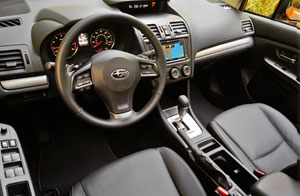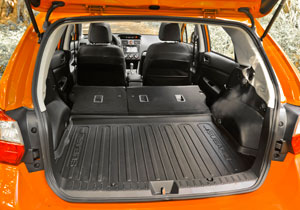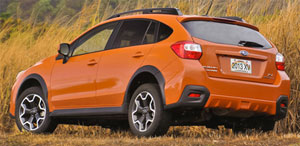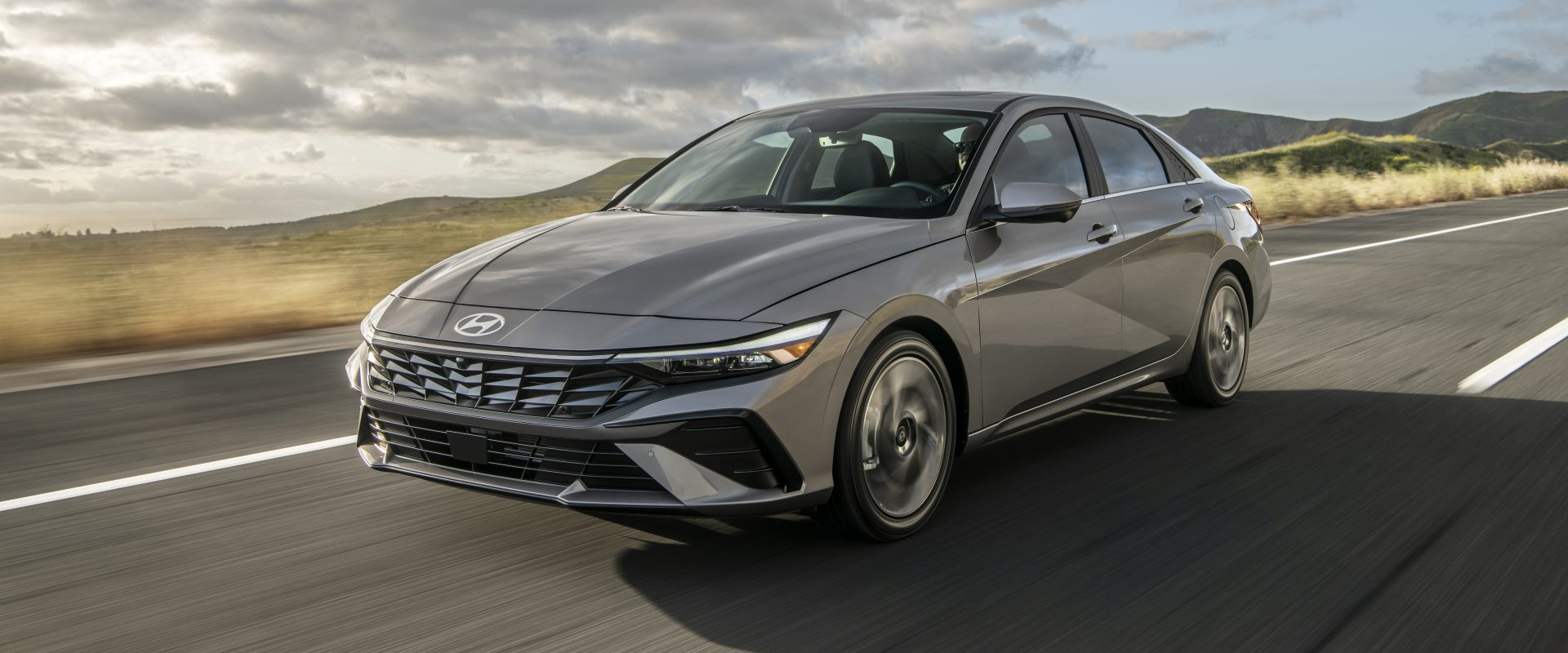2013 Subaru XV Crosstrek
Subaru has made a habit out of producing quirky little all-wheel-drive vehicles that may not become hugely popular, but achieve definite fan status. Remember the Brat and how about the Baja? Well, the latest is the Subaru XV Crosstrek. This jacked up Impreza can indeed tackle the trail to the campground, but it can also make its way through the urban jungle as well.
Subaru has long been known for the versatility of its all-wheel drive hatchbacks and wagons, striving for that perfect balance between SUV usefulness and small car practicality. But, no effort has nailed that equation better than the Impreza Sport based, 2013 Subaru XV Crosstrek. Not only does this urban crossover pack standard four-corner traction, 8.7 inches of ground clearance, and a rugged exterior design; it also boasts car-like comfort and good fuel economy. And it’s all wrapped in an easy to maneuver and park city friendly size.
8.7-inches is a surprising amount of ground clearance for any crossover, much less one this small. After all, the Jeep Grand Cherokee boasts just 8.6-inches. Curb hopping anyone? All that ground clearance turns this Impreza into a capable little Billy Goat off-road, as well. But it does come with a down side. Compared to the Impreza, Crosstrek’s ride quality is on the harsh side. The beefed up suspension resists pot holes, but also provides a very stable platform for uneven terrain.
 Sharing Impreza Sports’ 2.0-liter boxer engine means the driving experience is confident if not overly powerful with only 148-horsepower and 145 lb-ft. of torque on tap. Sadly, we won’t see the new twin-cam 2.0-liter diesel that’s available for Crosstrek in Europe. Those oh so lucky Europeans also get a 6-speed manual, while we must make do with a 5-speed as the standard transmission. Our test car came equipped with a whiney CVT auto.
Sharing Impreza Sports’ 2.0-liter boxer engine means the driving experience is confident if not overly powerful with only 148-horsepower and 145 lb-ft. of torque on tap. Sadly, we won’t see the new twin-cam 2.0-liter diesel that’s available for Crosstrek in Europe. Those oh so lucky Europeans also get a 6-speed manual, while we must make do with a 5-speed as the standard transmission. Our test car came equipped with a whiney CVT auto.
Nowhere is it more obvious that this is a modified Impreza Sport, than inside the cabin; as the dark, monochrome theme speaks volumes. But we’re not complaining, as it actually seems more fitting here in this rugged little runner. Though we will complain about the same hard to use touch-screen radio and sat-nav. system that’s located in the otherwise straightforward center-stack. In back, rear seat room is fine for three children or two adults. And the 22.3-cubic ft. of cargo space expands to 51.9 cubic-ft. with the rear seats folded.
Now it may just be our red necks showing, but we love the jacked up stance and tough, all-purpose look of the XV. Most of the body panels are the same as the Impreza Sport compact, but unique front and rear fascias, as well as the expected body cladding down the sides and around the fenders give it a much different look. We’re also fond of the cool black and silver 17-inch alloy wheels; though we’d quickly replace the 225/55 all-season rubber with some proper all-terrains to really complete the look.
 Government Fuel Economy Ratings are not as good as some compact hatchbacks, but pretty impressive compared to other all-wheel-drive crossovers; 25-City, 33-Highway, and 28-Combined. We averaged just 26.5 miles-per-gallon of Regular gas in mixed driving. Still, the Energy Impact Score comes in much better than average at 11.8-barrels of annual oil consumption with CO2 emissions of 5.2-tons.
Government Fuel Economy Ratings are not as good as some compact hatchbacks, but pretty impressive compared to other all-wheel-drive crossovers; 25-City, 33-Highway, and 28-Combined. We averaged just 26.5 miles-per-gallon of Regular gas in mixed driving. Still, the Energy Impact Score comes in much better than average at 11.8-barrels of annual oil consumption with CO2 emissions of 5.2-tons.
Despite being based on the Impreza Sport, that big boost in ground clearance classifies the XV as a Sport Ute. And at our test track, we were expecting a rather Jeep-like experience, but found the Crosstrek to be a capable handler. The much anticipated body roll never materialized; with understeer more of an issue.
It’s certainly not much to brag about off the line, as it crawls to 60 in a lazy 9.8-seconds and to the end of the quarter mile in 17.5-seconds at 79 miles-per-hour, about the same as the Impreza Sport. Braking was also similar at 121-feet, with standard ABS-equipped discs at all 4 wheels providing smooth and drama free consistent stops.
While the Crosstrek may have been designed more for the European market than ours, with the Forester growing in size, there’s actually room for it in Subaru’s lineup here, as well… and when it comes to pricing, it slides nicely right in between the Impreza Sport and a well-equipped Forester, starting at $22,790.
 Subaru buyers are a unique lot, and the 2013 Subaru XV Crosstrek is a unique vehicle that should suit more than a few of them. But unless you need the additional ground clearance, or just really like the tougher look, you’ll be fine with an Impreza Sport. So, whether your typical attire revolves around wearing hiking boots or loafers, Subaru has got a fun and capable compact just for you.
Subaru buyers are a unique lot, and the 2013 Subaru XV Crosstrek is a unique vehicle that should suit more than a few of them. But unless you need the additional ground clearance, or just really like the tougher look, you’ll be fine with an Impreza Sport. So, whether your typical attire revolves around wearing hiking boots or loafers, Subaru has got a fun and capable compact just for you.
Specifications
- Engine: 2.0-liter
- Horsepower: 148
- Torque: 145 lb-ft.
- 0-60 mph: 9.8 seconds
- 1/4 mile: 17.5 seconds @ 79 mph
- EPA: 25 mpg city/ 33 mpg highway
- Energy Impact: 11.8-barrels of oil/yr
- CO2 Emissions: 5.2 tons/yr
2024 Hyundai Elantra
Basic Transportation At Its Best…And That Is A Compliment
For those of you who write in every week bemoaning the fact that all we seem to do around here is test incredibly expensive cars and EVs that only the very well to do can afford, this one’s for you. It’s a commuter and budget friendly mainstay from Hyundai, the compact Elantra sedan. And, it has been nicely updated for 2024.
We clearly do enjoy driving high-performance machines and ultra-luxury rides around here, but like most of you, when it comes time to drive home at the end of a long workday, we do so in something much more practical and affordable, like this 2024 Hyundai Elantra sedan.
If you’re thinking the front end has gotten more aggressive, you’re right. Hyundai calls it a “Shark Nose” theme, and we’re guessing they were thinking more Great White than Hammerhead, though Megamouth shark would also apply. It helps for a low and wide look; more substantial than the typical compact. Other additions for ’24 include slimmer daytime running lights, revised stainless steel Hyundai emblem, reshaped front fenders, sport sedan-style rear diffuser with silver trim; a parametric pattern added to the C-Pillar, and new LED taillights that take up a lot more space on the highly sculpted decklid. Plus, new wheel designs in sizes ranging from 15- to 18-inches.
Standard engine in SE, SEL, and Limited grades is this naturally aspirated 2.0-liter I4 with 147 horsepower and 132 lb-ft of torque. Even with no hybrid assistance, it gets substantial Government Fuel Economy Ratings of 31 City, 40 Highway, and 34 Combined; we averaged a great 38.6 mpg of Regular.
Those high fuel economy numbers mean acceleration times are pretty high as well. It was in no particular hurry to get off the line at our test track, as after a slight jolt of power, it felt pretty sluggish going down the track, taking us a lengthy 9.4 seconds to hit 60 mph. Hyundai’s Intelligent Variable Transmission has some realistic simulated gear shifts built in, and they not only provided the feel of a true automatic, but kept engine noise from becoming overbearing. And while this 2.0-liter may not be a house-on-fire off the line, it has no problem keeping up with traffic, and feels like just the perfect amount of power for a practical and safe commuter car.
There are other engine options too. Two choices if you want to go faster, a 1.6-liter turbo with 201 horsepower in the Elantra N Line, and a 276-horsepower turbocharged 2.0-liter for the Elantra N; plus, one with even better fuel economy, a 1.6-liter hybrid with a 139 horsepower total output.
And despite some significant understeer, there was good feel through the cones of our handling course, both in steering and chassis feedback. We wouldn’t quite call it “point and shoot,” but it responded to inputs fairly quickly, with only moderate body roll. All-in-all, when it comes to performance, it doesn’t claim to bring a whole lot to the table, but does clearly overachieve with what it does bring.
And Hyundai is always overachieving when it comes to packing in features, yet has found a way of keeping things refreshingly simple with a good mix of touchscreen and manual controls. Lots of space too, both up front in the surprisingly wide front buckets, and in the rear bench with ample room for three. Updates for all Elantra interiors include softer materials on the door panels, upgraded instrumentation and additional charging ports, plus a surround view monitor and new H-Tex simulated leather for Limited trim.
Elantra pricing starts with an SE at $22,775, the SEL comes in at $24,725, Limited begins at $28,215, and the sporty N Line starts at $29,615. If you’re interested in the hybrid, base Blue starts at $27,400 with Limited at $30,600.
Some might say there’s not a whole lot that’s earth shaking about the 2024 Hyundai Elantra, but that’s mostly why we like it so much. When it comes to just delivering good, basic transportation with a high dose of unexpected amenities, Hyundai delivers once again.
Specifications
- Engine: 2.0-liter I4
- Horsepower: 147
- 0-60 mph: 9.4 seconds
- 60-0 Braking: 111 ft (avg)
- MW Fuel Economy: 38.6 MPG (Regular)
- Transmission: IVT
- Torque: 132 lb-ft
- 1/4 Mile: N/A (Track Maintenance)
- EPA: 31 City / 40 Highway / 34 Combined







